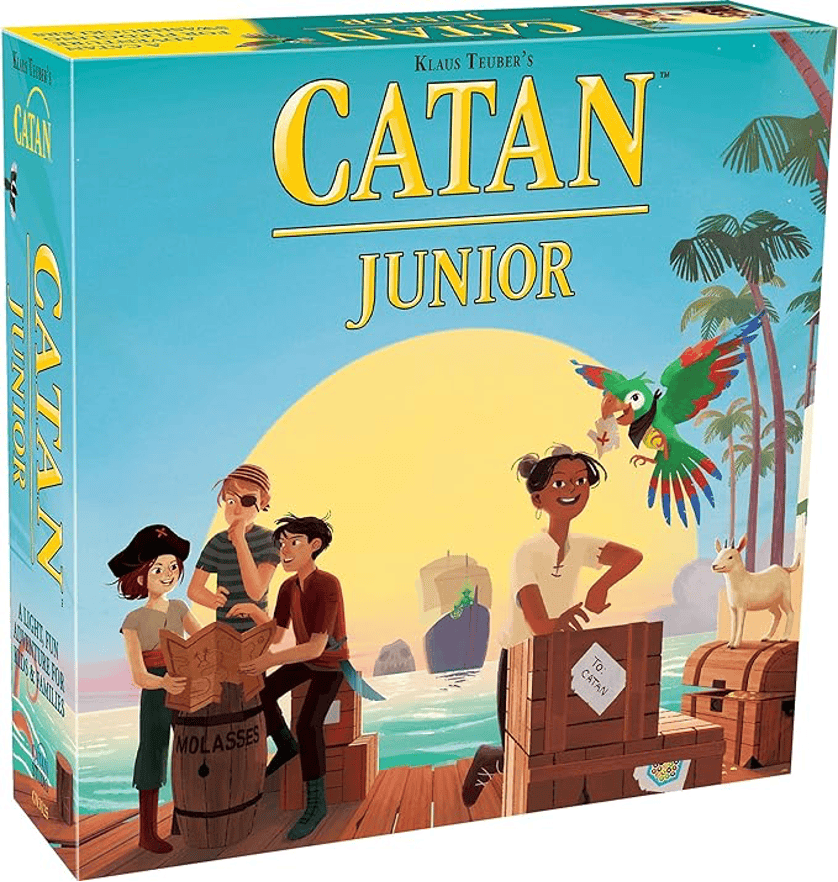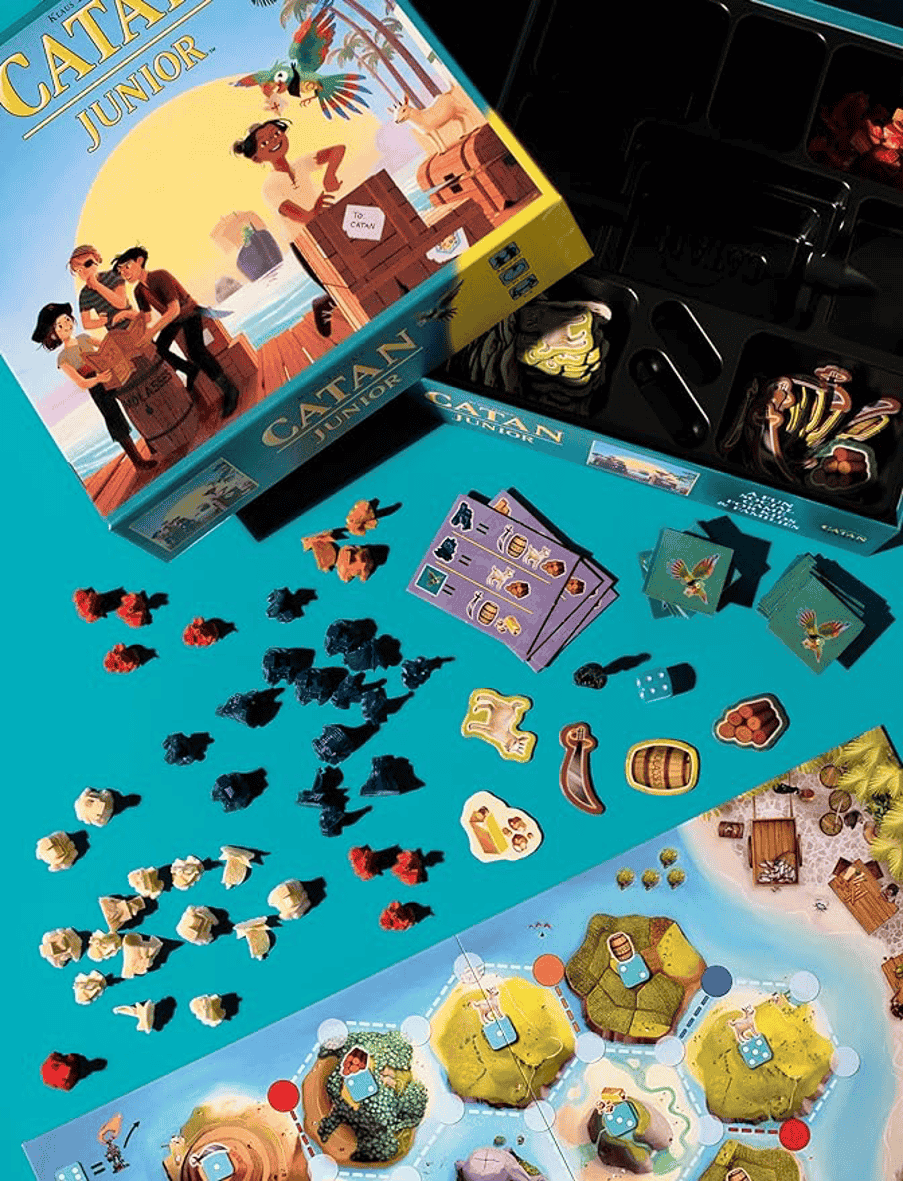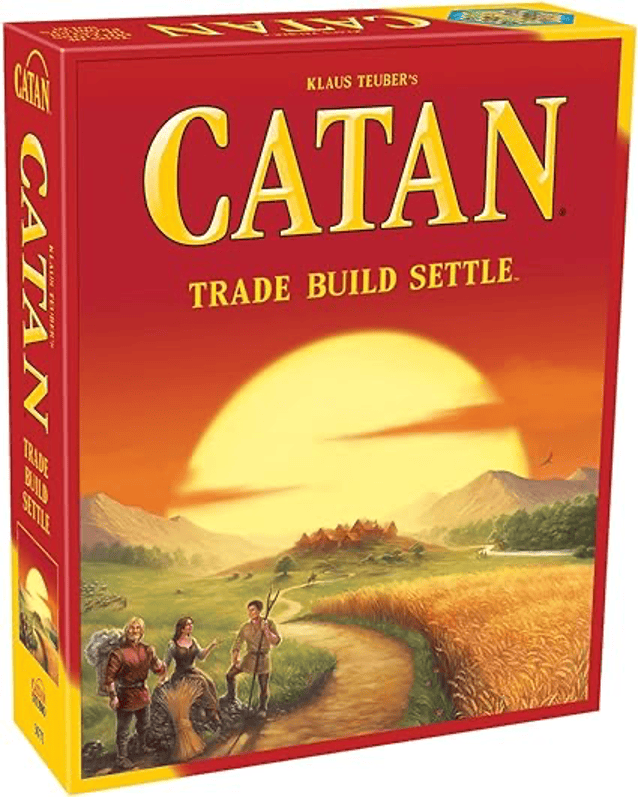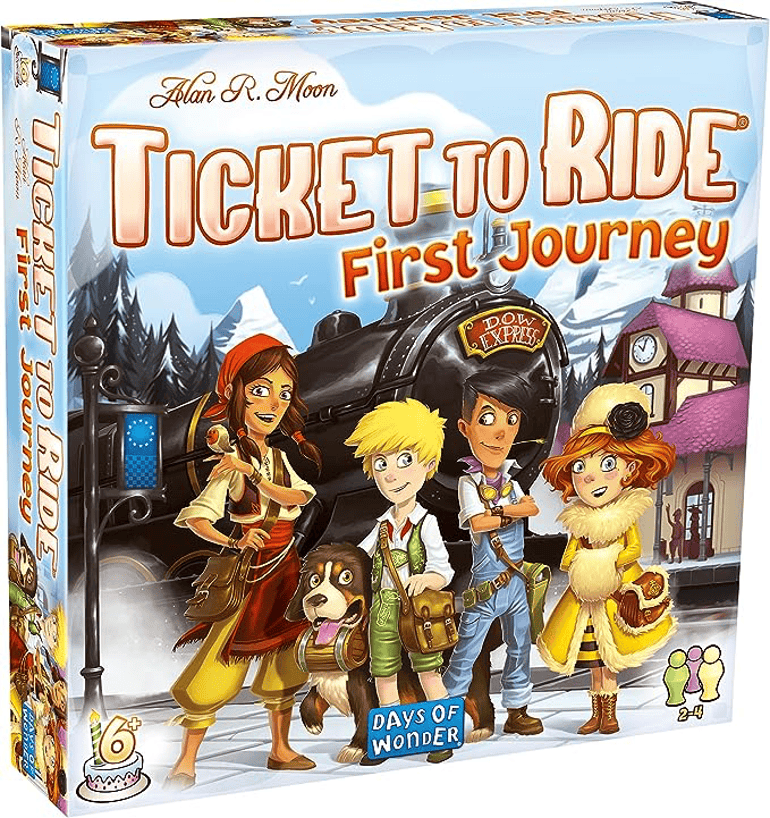
By: Catan Studios Players: 2-4 Ages: 6+ Time: 30 mins
The islands of Catan: lush forests, golden yellow sugar cane fields, volcanic cliffs, and mysterious caves! An ideal home for adventurous pirates!
These islands are begging to be explored and are filled with all kinds of goods and treasures ripe for the taking.
As pirates build their fleet and expand their reach with more lairs, they must be wary not only of other pirates but the ghost captain that haunts these isles and claims them as his own!
What Is Catan Junior for Younger Players?
Catan Junior spawned from the worldwide success of the original Catan. Catan was originally developed in 1995 in Germany and came about by the creator (Klaus Teuber) being inspired by Viking Settlers, with the titular island being modeled after Norway and Iceland. The game became so popular that over the years there have been over 30 expansions and spin-offs, Catan Junior being one of them.
Catan Junior came about in 2012 and took the same premise and gameplay as the original but with the intention of being more family-friendly. The board is smaller, there are fewer resources, and the mechanics are simplified, offering a simpler playing style designed for younger players. Players will collect resources each turn and use them to build pirate ships and lairs in order to spread their presence out across the many islands on the gameboard. Each player starts with two pirate hideouts on different islands. The first player to build seven pirate lairs is the winner.
How to Play Catan Junior Board Game

The game setup is simple and only takes a few minutes. Catan Junior Board Game is made up of thirteen islands (one of which is the mysterious Spooky Island, where the Ghost Captain resides) and a marketplace. Each island generates a specific resource wood, goats, molasses, or cutlasses. There are five resources in the game: cutlasses, goats, wood, gold, and molasses.
One of each of these is placed at the stalls at the marketplace with the rest going into a stockpile. The ‘Coco tiles” are shuffled and placed face down next to the board and the Ghost Captain is placed on Spooky Island. Each player chooses a color and places their lairs and ships on the starting spaces that share their asset’s color. Lastly, everyone starts with one wood and one molasses resource tile.
The youngest player always starts the game. A turn begins with the player rolling the dice to indicate which island generates resources that turn. Each island has a number and a resource associated with it.
Any player with a lair adjacent to an island whose number has come up will receive that resource, whether it’s their turn or not. If a player has multiple lairs adjacent to the island, they will receive one resource per lair.
If a “6” is rolled, nobody receives resources and instead, the dreaded Ghost Captain is moved to any other island of the active players’ choice. They then take two tiles of the resource produced by that island from the stockpile. No one will receive resource tiles from an island the Ghost Pirate is on, regardless of how many lairs they have adjacent to it.
Once the actions have been resolved from the dice roll, the active player can then build, buy, or trade-in any order they wish.
When players have accumulated enough resources they can build pirate lairs or pirate ships. Lairs are more expensive than ships but are essential in winning the game. These can be built on an empty lair site as long as there is a pirate ship adjacent to it. Likewise, ships can be built on an empty ship site, but only if it is adjacent to a pirate’s lair. Lairs and ships are essentially built in an alternating fashion but cannot occupy other players’ spaces. Players use resources like wood, goats, and molasses to build ships and lairs.
If they have enough resources, players can purchase Coco tiles which will grant the player certain benefits. They may receive free resources, be able to move the Ghost Captain as if they’d just rolled ‘6’, or possibly even build a lair or ship for free. These tiles have no negative results and it’s always worth investing in them now and then.
If players don’t have the resources they need then they may trade with the nearby market or the stockpile. When trading with the market, players must replace what they take with one of their own resources so all five stalls are occupied with something. If the market doesn’t contain what a player needs they may trade with the stockpile, however, players must trade two matching resources in return for the one they take. Suffice it to say this isn’t always ideal but works in a pinch.
As an optional rule, players may trade resources with each other. If on a player’s turn, they’re lacking a resource they can trade with another player, but only one tile may be exchanged.
Play continues with players resolving dice rolls, building, buying, and trading until someone manages to construct seven lairs and becomes the winner.
Original Vs Junior: Simpler Playing Style

For those curious about the differences between the OG and JR Catan, you’ll be pleased to know that what has changed enhances and streamlines the gameplay for younger audiences without taking away from what made Catan great. Catan Junior takes place on a ring of tropical aisles, each generating specific resources.
Some of the changes are purely aesthetic for branding purposes (the pirate theme, the Coco tiles replacing development cards, the Ghost Captain replacing the robber) and don’t really affect gameplay in the slightest. In fact, the Coco tiles and Ghost Captain are utilized in more or less the same way as the original Catan. One of the islands is the mysterious Spooky Island, where the Ghost Captain resides. The bigger changes, like shrinking the game board and reducing the number of resources, will be barely noticeable for veteran gamers and make the game much more enjoyable for younger ones.
Children of a certain age won’t be able to digest too many rules or sit for longer than a certain amount of time and Catan Junior balances this very well. With the average play time of Catan Junior being around 30 minutes and its parent game being at least twice as long, it’s much more likely kids will make it through to the end of the former rather than the latter, especially with the visually entertaining pirate aesthetic to capture their imagination.
The great thing is, with the rules being almost identical between the two games, if kids enjoy Catan Junior then they should find Catan not just easy to get to grips with but enjoyable also. Understanding the concepts of Catan and learning the new rules will be a painless transition for anyone having already played the junior version.
Check out our full review of Catan here.
Summary
The original Catan but simpler
Short playtime
Strategic depth
Builds on social skills
Pirates!
Build pirate hideouts and acquire more resources to win the game
We earn a commission if you make a
purchase, at no additional cost to you.
Final Verdict

Catan Junior Board Game takes what was great about the original game and does an excellent job of scaling it down for families and younger players. Having fewer resources to keep track of and a smaller board means younger players shouldn’t feel overwhelmed. Despite this, the game still offers a degree of strategy and an appropriate challenge for the target age group. Simpler rules, a shorter play time, and an entertaining pirate aesthetic make for an easily accessible and enjoyable game. The first player to control seven pirate hideouts wins the game, adding an exciting goal that encourages strategic building and expansion.
If you liked this…

If you or your kids enjoy Catan Junior and want something similar or slightly more challenging, below are a handful of games you should try next:
Catan: The same gameplay as Catan Junior but on a bigger scale. Trade resources, build roads and cities, and bolster armies to gain victory points, with the first player to ten becoming the winner.
Carcassone: A tile drawing and placement game. Construct the largest cities, roads, monasteries, and fields and score the most points by laying down followers strategically.
Ticket to Ride First Journey: Build train routes across Europe by playing matching colored train cards. The first player to complete six routes will receive the Golden Ticket and win the game.
Read our full review of Ticket to Ride: First journey.
My Little Scythe: A version of Scythe for younger gamers. Take two animal miniatures on an adventure in the Kingdom of Pomme. Earn four trophies by completing a variety of quests to be declared the winner.
Small World: Fuse races and abilities together to create the strongest army to take over the small world. Place counters on a segmented map to control as much territory as possible. An ever-changing fantasy version of Risk.
FAQ
Q: What age group is Catan Junior suitable for?
A: Catan Junior Board Game is designed for children aged 6 and above. The simplified rules and shorter play time make it accessible for younger players.
Q: How long does it take to play Catan Junior?
A: The average playtime for Catan Junior is around 30 minutes, making it a quick and engaging game for family game nights.
Q: Can adults enjoy playing Catan Junior?
A: Yes, adults can enjoy playing Catan Junior, especially when playing with younger children. While the game is simplified, it still offers strategic elements that can be fun for all ages.
Q: How is Catan Junior different from the original Catan?
A: Catan Junior features a pirate theme, fewer resources, and simplified mechanics. It also has a smaller game board and a shorter play time, making it more suitable for younger audiences.
Q: Can Catan Junior be played with fewer than four players?
A: Yes, Catan Junior can be played with 2 to 4 players. The game adjusts well to different player counts while maintaining its strategic depth.
Q: Are there any expansions or additional content available for Catan Junior?
A: As of now, there are no official expansions for Catan Junior. However, the base game provides plenty of replayability with its dynamic setup and strategic elements.
Q: Is there any text reading required in Catan Junior?
A: Catan Junior contains minimal text, making it accessible even for children who are still developing their reading skills. The game primarily relies on visual cues and simple instructions.
Q: What skills does Catan Junior help develop in children?
A: Catan Junior helps develop strategic thinking, resource management, and social interaction skills. It also encourages planning and decision-making in a fun and engaging way.
Q: Are there any special characters in Catan Junior?
A: Yes, players must watch out for the dreaded Ghost Captain while building their pirate hideouts on the ring of islands. This character adds an exciting element to the game.
